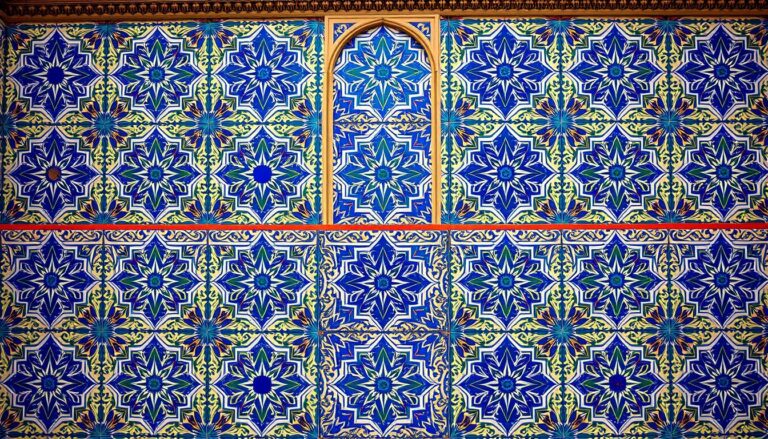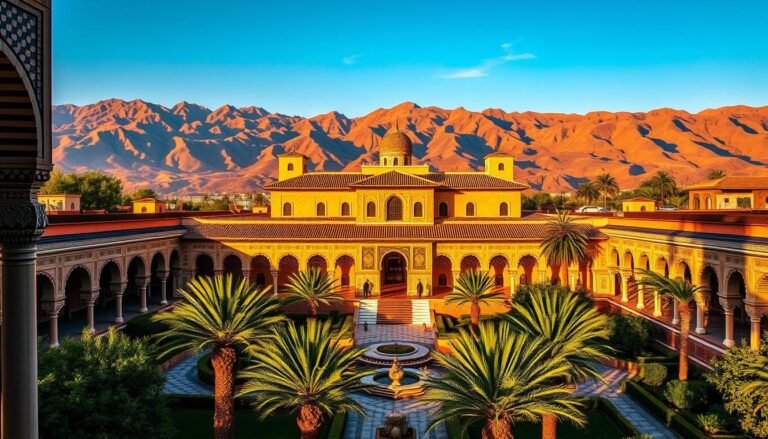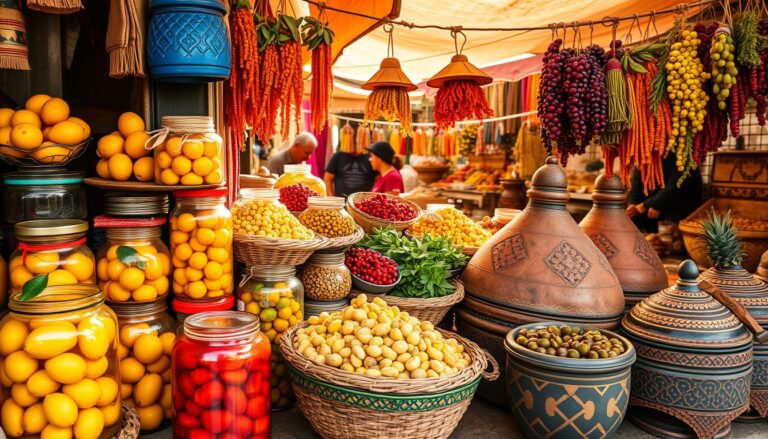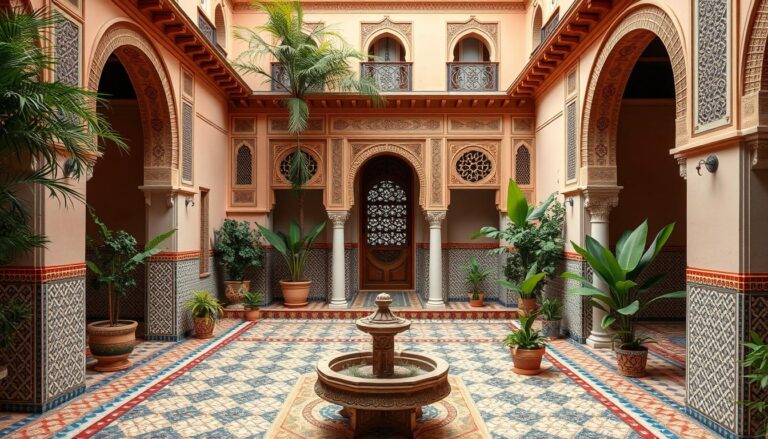Have you ever wondered about the awe-inspiring fortresses in Morocco? These architectural wonders, known as Kasbahs, have amazed the world. They are filled with history, strategic importance, and cultural value.
The word “Kasbah” comes from Arabic, meaning “fortress” or “citadel.” Kasbahs were key in Morocco’s past. They were military strongholds, royal homes, and centers of power and social life. Let’s dive into the world of these ancient fortresses and see how they shape Moroccan identity.
Key Takeaways
- Kasbahs are fortified citadels that have played a significant role in Moroccan history and architecture.
- These ancient structures showcase a blend of Berber, Arab, and Andalusian architectural influences.
- Kasbahs were strategically located to serve as military strongholds and centers of political and social organization.
- The Ksar of Ait-Ben-Haddou, a UNESCO World Heritage Site, is considered an outstanding example of traditional pre-Saharan earthen architecture.
- Efforts are underway to preserve the architectural heritage of Kasbahs in Morocco, ensuring their enduring legacy.
Introduction to Kasbahs: Fortified Citadels of Morocco
In Morocco’s heart, a special architectural wonder stands out – the Kasbah. These fortified citadels, rooted in the country’s Berber heritage, have shaped Morocco’s identity and history. The word “qasaba,” meaning “fortress” or “citadel,” shows their importance. Kasbahs have been key administrative centers and social hubs for centuries.
Definition and Historical Background
A Kasbah is a fortified area or citadel in a Moroccan city. It’s often built on a hilltop or near water to protect people from invaders. These medieval fortresses, with their high walls, narrow alleys, and decorated gates, show a mix of Berber, Arab, and Andalusian styles. Kasbahs have been military strongholds, royal residences, and a big part of Morocco’s cultural heritage.
Significance of Kasbahs in Moroccan Culture
Kasbahs have been crucial in Morocco’s social and political life. They’ve housed government offices and courts, and been centers of local traditions and celebrations. Kasbahs have hosted festivals, markets, and social events, building community and preserving culture. These fortified citadels show Moroccan builders’ skill and the country’s deep connection to its past.
“Kasbahs are not just architectural marvels, but living embodiments of Morocco’s rich cultural tapestry, seamlessly blending the past and present.”
Architectural Features of Moroccan Kasbahs
Moroccan Kasbahs are fortified citadels that stand out in the landscape. They mix mud-brick architecture, pisé construction, and earthen structures with local materials. These defensive buildings are found on hilltops or near desert oases. They show how people used available resources to build both useful and beautiful structures.
Construction Materials and Techniques
The walls of Kasbahs are built using the “pisé” method. This involves layers of wet clay that form solid, insulating walls. Wooden beams and palm trunks are used for the roofs. Decorative elements like stucco and tiles add beauty.
This approach not only fits well with the surroundings but also keeps the inside cool in hot summers and warm in cold winters. Morocco’s varied climates make this important.
Defensive Elements and Strategic Locations
Kasbahs are built with defense in mind. They have thick walls and towers at the corners for a good view. Their location on hills or near water adds to their defense, helping to watch the area and keep out threats.
The design and location of Moroccan Kasbahs show the area’s cultural history. They also highlight the people’s ability to protect their communities from danger.
“The Kasbahs of Morocco are not merely architectural marvels, but also tangible representations of the region’s rich cultural heritage and the ingenuity of its people in adapting to their environment.”
Historical fortresses (Kasbahs) and Moroccan Architecture
Moroccan architecture is a mix of Berber, Arab, and Andalusian styles. Kasbahs are a great example of this mix. These fortified citadels have changed over time, adapting to new political, social, and environmental changes.
Blending of Architectural Influences
The Berber influence is clear in the use of clay and stone in Kasbahs. Arab influences show in the detailed decorations, like geometric patterns and calligraphy. Andalusian touches are seen in the courtyards and gardens. This mix shows Morocco’s rich history of conquests, trade, and cultural exchange.
Evolution of Kasbah Architecture
Kasbahs have changed over the years to fit their occupants’ needs. Some grew to house more people, while others got stronger defenses. The French colonial era saw many Kasbahs left unused or changed for new uses. But, there’s now a push to save and restore these historic sites, keeping Morocco’s architectural heritage alive.
“Moroccan Kasbahs are a testament to the country’s rich architectural heritage, blending Berber, Arab, and Andalusian influences into a unique and captivating form of fortified architecture.”
The changes in Kasbah architecture show Morocco’s ever-changing politics, society, and culture. These ancient fortresses still amaze visitors and stand as symbols of Morocco’s architectural past.
Iconic Kasbahs of Morocco
In Morocco, the Kasbahs are a treasure trove of architecture and history. Two of these sites are especially famous. They are a must-see for anyone wanting to dive into Moroccan culture and architecture.
Kasbah of Aït Benhaddou: A UNESCO World Heritage Site
The Kasbah of Aït Benhaddou is a UNESCO World Heritage Site. It’s on the old route between the Sahara and Marrakech. Its red mud-brick walls have amazed visitors and filmmakers, making it a key spot for desert tours.
Kasbah of Taourirt and Kasbah of Telouet
In Ouarzazate, the Kasbah of Taourirt is a marvel of Moroccan architecture. It was home to the Glaoui family and now shows off Berber culture and history. The Kasbah of Telouet, in the High Atlas, was the Glaoui family’s stronghold. It’s known for its lavish interiors and intricate designs.
“The Kasbah of Aït Benhaddou is a true architectural marvel, capturing the essence of Morocco’s desert heritage.”
These Kasbahs are not just buildings; they are windows into Morocco’s past. They are a testament to the country’s rich history and culture. They are a must-see for anyone exploring Morocco’s architectural wonders.
Life and Culture Within the Kasbahs
Inside a Moroccan kasbah, life followed a strict social order. The ruling family lived in the center, while others resided around them. The kasbah was a center for social, economic, and political life. It had areas for storage, workshops, and community gatherings.
Daily life was filled with various activities. People worked in agriculture, crafts, trading, and socializing. Festivals and celebrations brought the community together. These events, like religious holidays and weddings, were filled with feasts, music, and dance. They helped keep the social organization strong and the cultural traditions alive.
“The kasbah was not just a fortress, but a living, breathing community that embodied the essence of Moroccan heritage.”
The kasbah’s social organization created a strong sense of belonging. Daily life, from meals to maintenance, built lasting bonds. These bonds formed a collective identity that has lasted for generations.
The Kasbahs of Morocco are famous worldwide. Their festivals and celebrations show the kasbah communities’ enduring spirit. These fortresses have stood the test of time, keeping Morocco’s cultural heritage alive.
Conclusion: Preserving Morocco’s Architectural Heritage
Keeping Morocco’s historic kasbahs safe is a big task. But, people are working hard to fix and keep these old fortresses. They are important because they show the country’s rich history and culture.
Groups like the government, non-profits, and local people are teaming up. They are fixing walls, roofs, and decorations. They also protect the kasbahs from nature’s harm.
Some kasbahs now serve as hotels, museums, and cultural spots. This way, they stay true to their past but also meet today’s needs. This approach keeps the kasbahs alive and lets people enjoy them.
Modern buildings in Morocco also show the kasbah’s influence. Architects use thick walls, courtyards, and designs from the old days. This mix of old and new keeps Morocco’s culture alive in its buildings.
Source Links
- Fortified Kasbahs and Palaces
- Ksar of Ait-Ben-Haddou
- Unlocking the Secrets of Morocco’s Ancient Kasbahs: A Journey Through History and Architecture – the kasbahs and Oasis in Mrorocco
- Aït Benhaddou: Morocco’s Enchanting Kasbah & UNESCO World Heritage
- Legends of the Road of a Thousand Kasbahs – ARCHAEOTRAVEL.eu
- Moroccan Architecture
- What Type of Architecture Is Morocco Known for?
- Architecture In Morocco: 15 Uniques Buildings Every Architect Must See
- What is a Kasbah? A Comprehensive Guide to Morocco’s Ancient Fortresses
- Moroccan architecture
- From Islamic to Art Deco: A rich history of Moroccan architecture
- The most beautiful kasbahs in Morocco – Morocco travel guide
- Authentic Famous Kasbahs in Morocco: Ait Ben Haddou
- The Ultimate Guide to Exploring Morocco’s Kasbahs
- Moroccan Architecture – Kasbahs & Ksours, Medinas and Mellahs
- Ksours and Kasbahs
- Preservation Strategies for Southern Morocco’s At-Risk Built Heritage
- The Fascinating Kasbahs of Morocco: History and Architecture
- Road of a Thousand Kasbahs Itinerary in Morocco

The Editorial Team is a passionate group of Morocco enthusiasts dedicated to sharing the beauty, culture, and wonders of this captivating country. With diverse backgrounds and a deep love for travel, we strive to bring you engaging and informative content that inspires your Moroccan adventures. From uncovering hidden gems and sharing local insights to exploring mouthwatering cuisine and showcasing the vibrant lifestyle, our team is committed to providing you with valuable resources and exciting stories that enhance your exploration of Morocco. Join us on this journey as we celebrate the rich heritage and unforgettable experiences that make Morocco truly special.







